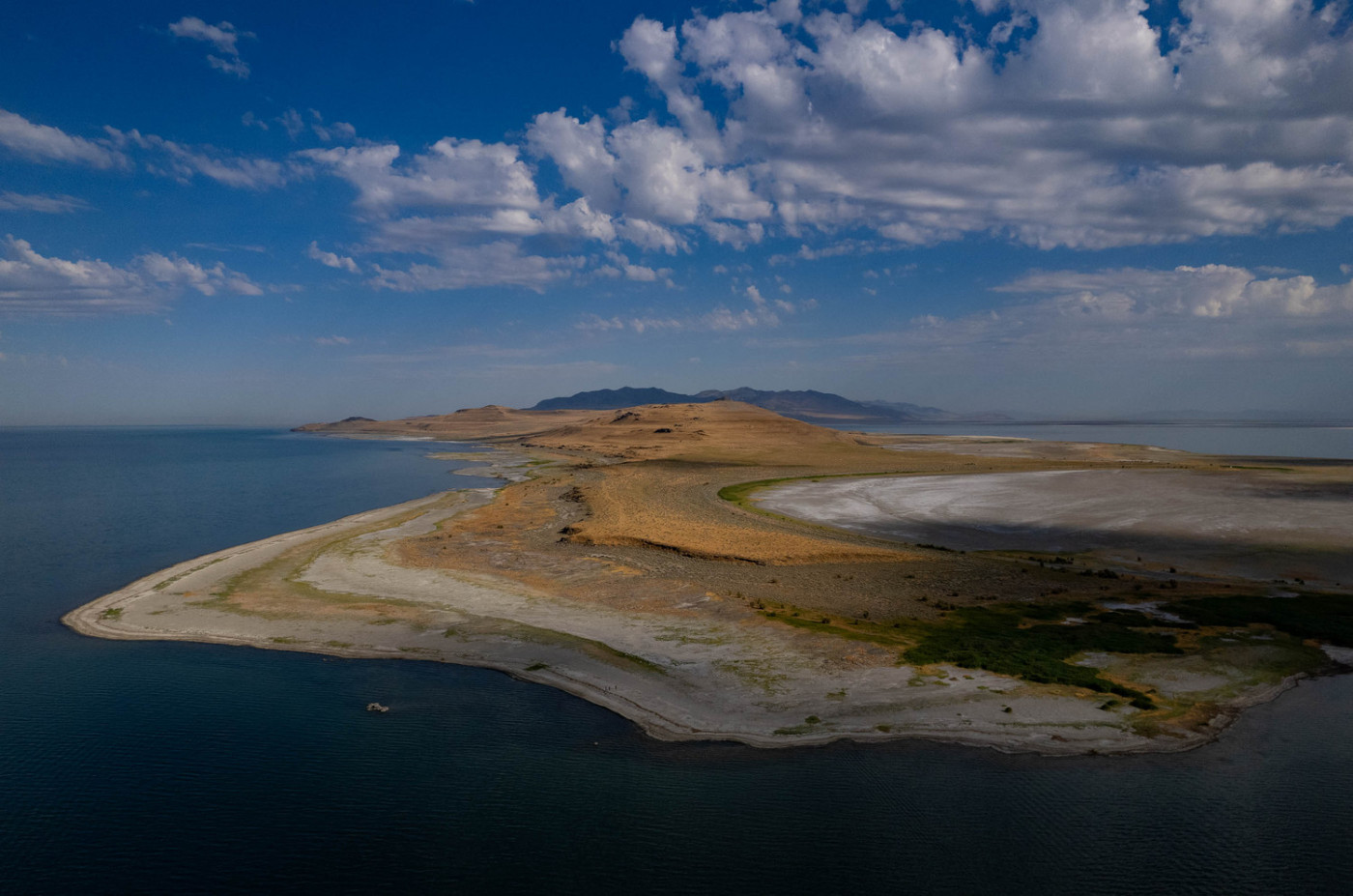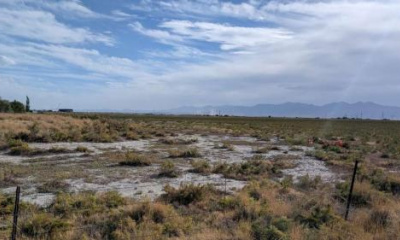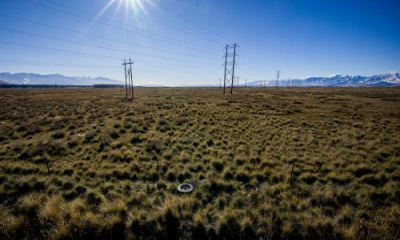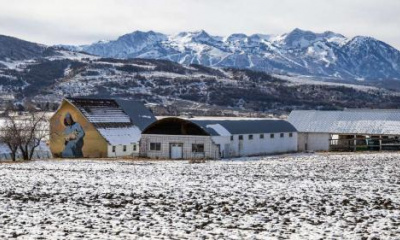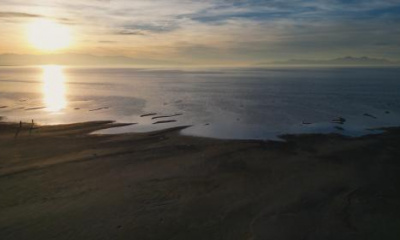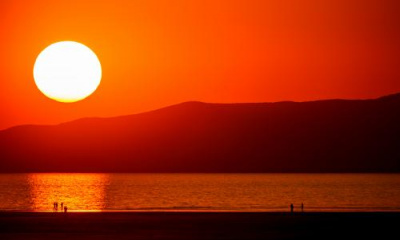Don’t expect shade, camping, trails or easy access. But the Great Salt Lake’s third-largest island is still a gem worth exploring and celebrating.
Great Salt Lake • After a few years pondering what to do with Fremont Island, state resource managers have landed on something novel. They’re going to leave it alone.
There will be no concessions, no campgrounds, no causeways. There are no plans to build trails, restrooms or roads. State managers won’t even share information on where to find some of Fremont Island’s historical highlights, like the cross Kit Carson carved back in 1843 or ancient indigenous rock art. But visitors willing to devise a way to get out there are welcome to search and roam all they want, as long as they leave things intact.
“Right now, our primary goal is preserving the island as is,” said Marisa Weinberg, interim Great Salt Lake coordinator for the Department of Natural Resources, during a recent trek to document some of Fremont’s artifacts.
In some ways, Fremont Island will be wilder than actual designated wilderness areas, because the state won’t even allow livestock grazing, except, potentially, in a few fringe areas where invasive phragmites grow.
There are hints here and there of the island’s human past — a weathered wooden shack, an empty wine bottle, a gravesite, fragments of rubber tires, some old vehicle tracks. But travel to Fremont Island and you’ll likely find yourself alone, save for a few native critters like deer, rodents and birds. And that’s the way things likely will remain.
“What the state is putting together is logical, and I’m glad Fremont Island is going to be protected,” said Lynn de Freitas, executive director of FRIENDS of Great Salt Lake. “It’s something that, for the longest time, has been at the whim of someone who comes along and just decides to do something with it. That was so troubling.”
The decision marks a big milestone in the Great Salt Lake’s history, especially since white settlers have tried making a buck off Fremont Island from the moment they arrived in the Salt Lake Valley.
John C. Fremont, the island’s namesake, hoped to find an oasis chock full of wild game and water. After surveying the treeless, rugged, crescent-shaped land, he called it “Disappointment Island.”
That didn’t deter some sheepherders who ferried their flocks over to graze several years later. Railroad companies owned parts of the island during construction of the transcontinental railroad. Homesteaders briefly took up residence. Speculators poked around the island looking for ore during the Gold Rush. A slate mine operated on Fremont Island for a while.
“Just imagine trying to carry those giant slabs, getting them onto a boat,” Weinberg said. “Brutal.”
In more recent years, Barrow Land and Livestock leased the island from its private owners, stocking it with bison, wild boar and goats in an effort to lure rich exotic game hunters. State regulators put an end to that venture when they found a boar wandering near the neighboring Antelope Island causeway.
A group affiliated with the Diesel Brothers — the reality show stars sued by local environmental groups for illegally tampering with trucks so they could “roll coal” — bought Fremont Island in 2018. They even tricked out an old school bus with monster truck tires so it could drive across the lake and access their new playground.
“They did a lot of damage” to the island, Weinberg said, pointing out tracks still visible across the drying lakebed. “They wanted to develop it for recreation, so they were looking at putting in off-road trails. They wanted to put in a concert venue and horse racing and all this stuff. And I think they pretty quickly realized that it’s a little difficult to get things out here.”
The group even dreamed of one day building a 12,000-unit housing development on the island.
“It’s not [like] owning an island on the Caribbean or Lake Tahoe or whatever,” Weinberg said. “Great Salt Lake is unique.”
The Diesel Brothers have helped the state repair some of their damage and remove trash from the island, Weinberg said.
In November 2020, a private philanthropist with the Palladium Foundation bought the island and donated it to The Nature Conservancy, which in turn gave it to the Utah Division of Forestry, Fire and State Lands to manage under a conservation easement.
Under that agreement, no more motorized travel is allowed on Fremont Island. Visitors can only traverse by foot or by bike.
How to get to Fremont Island
Weinberg finished the state’s management plan for the island in May.
The plan documents the site’s history and also details potential routes to access it. The Utah Department of Transportation will maintain two airstrips for small planes. Boats can launch from the Antelope Island Marina and reach Fremont Island when the Great Salt Lake has enough water. Or, those with more time and fortitude can make the seven-mile trek across the sandbar between Antelope and Fremont islands when the water is low, either by foot, bike or e-bike.
Those making the journey to Fremont should come prepared, however. Overnight camping is not allowed. Cell service is spotty. There is no shade or fresh water. Venomous black widow spiders abound. Biting gnats can be downright murderous in warmer months.
“We came out here in spring 2021, just after we acquired the island,” Weinberg said. “It was prime no-see-um hatching time, and by the end of it we looked like we had some crazy disease, covered in bites.”
The island also has trail cameras, which instantly beam footage of visitors to state law enforcement, in case would-be vandals try to loot or damage anything. But Weinberg said she doubts those who make such an arduous trek would come with bad intentions. They’ve only seen about 30 people a year visiting Fremont Island so far.
For those who know how to rough it, however, there’s a lot on Fremont Island to enjoy.
“It’s really a good place to experience the nature of Great Salt Lake and potentially spot some new species,” Weinberg said. “We’re still in this exploratory phase of getting to know the island and having the public report back on their findings.”
The lake’s third-largest island, Fremont is about two miles wide and six miles long, with about 3,000 acres to explore.
Adolph Yonkee, a professor in the Earth and Environmental Sciences department at Weber State University, has made several treks to Fremont Island to study its geology since the mid-1990s. Although early mining prospectors didn’t find much value in its rocks, Yonkee said the place is full of gems.
“It’s a geological treasure,” he said, “so [state management] will help preserve that.”
The island contains rocks as big as cars moved by glaciers some 700 million years ago, during a period called “Snowball Earth” when the planet was covered by ice. There are ancient lava flows from when the Rodinia supercontinent began to rip apart.
“It’s really amazing to think about, to try and visualize what the Earth looked like,” Yonkee said, “and the cycles it went through.”
Now a desolate formation surrounded by some of the saltiest water on the globe, Fremont Island remains a monument of extremes.
“Don’t expect shade,” Yonkee said, “but expect stark beauty.”
Although many Utahns will likely avoid the grueling trip and challenging conditions at Fremont Island, Weinberg said the state’s management of the site represents a big win for all residents. And it means there are no more private islands on the Great Salt Lake, an invaluable public resource.
“It’s a conservation success that we’re able to manage Great Salt Lake as more of a wholistic piece,” she said. “It’s protected, it’s going to be conserved.”

